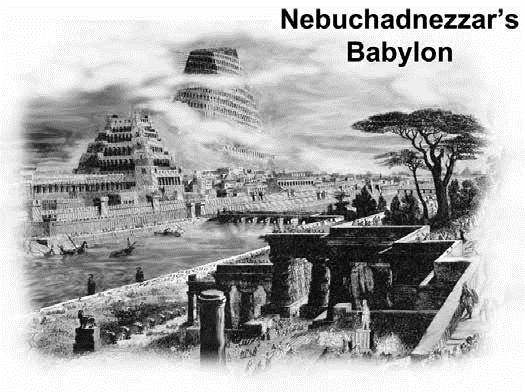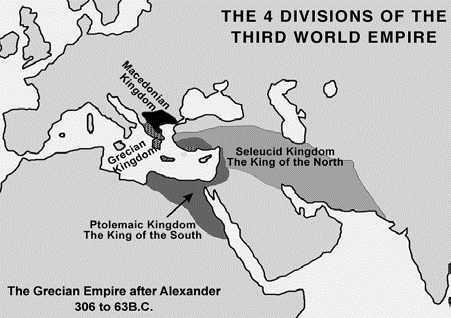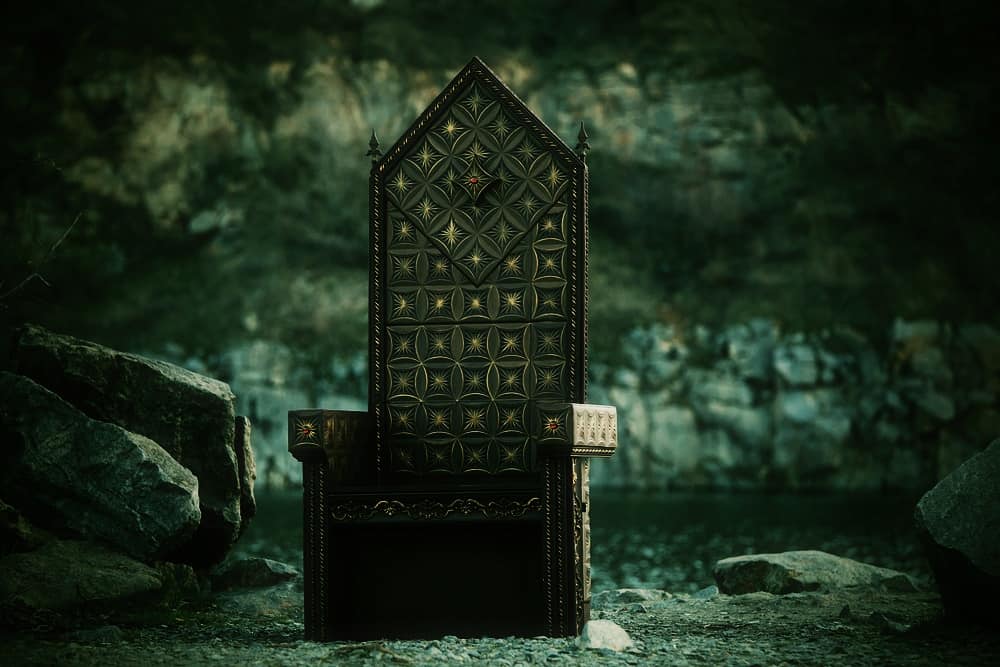
Where Satan's Throne Is is also available as a PDF Download
286.95 KB 10114 downloads
by John Ecob
In the time of Isaiah (780-690BC approx.) the dominant powers were Egypt and Assyria. Babylon and the area of Chaldea were part of the Assyrian Empire yet thirteen times Isaiah mentions Babylon in his prophecies for it was the place of Satan’s throne.
Babylon was established by Nimrod, the son of Cush, the grandson of Ham, about 2250 BC.
Babylon was where the line of Ham spread idolatry in opposition to the Godly line of Shem from which Abram came.
When Babylon was built by Nimrod, Asshur, a son of Shem, separated and built Nineveh about 400 km north of Babylon on the Tigrus River. It might well have been that Asshur, from the godly line of Shem, built his own city to escape the corruption in Babylon (Gen.10:11).
About 800BC Jonah went to Nineveh and announced Divine judgment against the city which had become evil and the king called the whole city to repentance. At that time the king feared the Lord greatly which may indicate that he had prior knowledge of the Lord.

About 2000BC Abram was told to get out of UR which was a leading city of Chaldea, and to go to the land of Canaan. We know from archealogical research that Ur was an idolatrous city dominated by pagan temples.
The land of Canaan to which God sent Abram was inhabited by the Canaanites who descended from Canaan, the brother of Cush. God placed a curse on Canaan (Genesis 9:25) when his father Ham might light of the nakedness of Noah.
Canaan was the uncle of Nimrod and it is not surprising to find Babylonian influence in the land of Canaan when Joshua led Israel into the promised land. At that stage the Canaanites were exceedingly wicked and Joshua’s army was the Divine instrument to destroy them.
In the conquest of Jericho (1450BC) Achan, an Israelite, took a “goodly Babylonish garment” and hid it in this tent. This was not just a quality garment but a priestly garment worn in the worship of Babylon’s Deities. Achan and his family who were complicit with him in the matter, were put to death for touching the “accursed thing”.
Babylon’s influence spread among all nations and the gods of Babylon were worshipped under different names in Egypt, Greece and Rome.
Israel was plagued with Babylon’s influence and brought herself into judgment for it. Again and again the people turned to Babylonian idolatry and reaped the consequences.
For a while in the days of Pul, King of Assyria, the Babylonians appear to have dominated the Assyrian Empire. Pul is a Babylonian name and perhaps for this reason was omitted from the Assyrian list of kings. Some have suggested that Pul was another name of Tiglathpiler but 1 Chronicles 5:26 makes it clear that they were different personalities.
Eventually Babylon rose up against Assyria and Nineveh was captured by the combined forces of the Babylonians and the Medes in 612BC. The western part of the Assyrian Empire had already been occupied by the Scythians who came from north of the Black Sea, through the Caucasus, captured the kingdom of Lydia, and ruled it for 28 years. The kingdom of Lydia in Asia Minor revolted against the Scythians but was not restored to Assyria.
After the Assyrian army of Sennacherib was destroyed by the angel of the Lord in the days of Hezekiah, we read:
Merodachbaladan, the son of Baladan, king of Babylon, sent letters and a present to Hezekiah: for he had heard that he had been sick, and was recovered (Isaiah 39:1).
No doubt the king of Babylon was delighted when the Assyrian army was destroyed and revolted against the Assyrians. However, history records that Sennacherib raised another army and destroyed Babylon, its walls and temples. However, Babylon was rebuilt in the days of Esarhaddon (670 – 680BC), the son of Sennacherib. Esarhaddon spent several years subduing the Phoenicean coast and nothern Israel (677 – 676BC) and Egypt (674 – 671). It was probably about this time that Esarhaddon bound idolatrous Manasseh King of Judah, and took him to Babylon. When Manasseh repented of his wickedness he was released and restored to his throne in Jerusalem (2 Chronicles 33:11-13).
The arrival of the messengers of Merodach-baladan in Jerusalem was welcomed by Hezekiah as Isaiah records:
Hezekiah was glad of them, and shewed them the house of his precious things, the silver, and the gold, and the spices, and the precious ointment, and all the house of his armor, and all that was found in his treasures: there was nothing in his house, nor in all his dominion, that Hezekiah shewed them not (Isaiah 39:2).
The name of Merodach-baladan indicates the Babylonian king was deeply involved, perhaps the high priest, of the chief Deity of Babylon, Bel, for Merodach was the Hebrew name for Bel.
Hezekiah’s compromise brought judgment on the nation and Isaiah was sent to tell him that the Babylonians would come and take all the treasures they had been shown to Babylon. God said:
Behold, the days come, that all that is in thine house, and that which thy fathers have laid up in store until this day, shall be carried to Babylon: nothing shall be left, saith the LORD (Isaiah 39:6).
Satan’s Throne in Babylon
In Isaiah chapter 14 and verse 4 we have a “proverb against the king of Babylon”. It is clear however that the personality behind the king of Babylon in Isaiah’s day was Satan for he is addressed as “Lucifer, son of the morning” (Isaiah 14:12) who had said in his heart,
I will ascend into heaven, I will exalt my throne above the stars of God: I will sit also upon the mount of the congregation, in the sides of the north: I will ascend above the heights of the clouds; I will be like the most High (Isaiah 14:13-14).
This action had brought judgment and Lucifer had been cast out of heaven. In Isaiah’s day Satan possessed the King of Babylon and the throne of Babylon was therefore Satan’s throne.
Satan is the “god of this world” (2 Corinthians 4:4) and the nations are under his control as he indicated to the Lord on the Mount of Temptation (Luke 4:6). After the Flood Babylon was the capital city of Satan’s domain; it was where Satan’s throne was located. Other kingdoms were controlled by “principalities and powers” and these were the “the rulers of the darkness of this world” (Ephesians 6:12) but Satan personally ruled the kingdoms of this world from Babylon.
Daniel records how Michael contended with the “prince of the kingdom of Persia” (Daniel 10:13) and when he left Daniel, Michael contended with the “prince of Grecia” (Daniel 10:20). These are demonic princes over nations.
Satan’s Throne in Tyre
When Babylon was destroyed by Cyrus, Belshazzar was drinking wine from the vessels of the Temple of the Lord in an act of blasphemy and defiance. At this time Belshazzar was slain. Satan’s reign in Babylon had come to an end and his operations were moved to the city of Tyre during the Persian era. The king of Tyre was a man possessed by Satan as we read in Ezekiel 28.
When Ezekiel took up a lamentation for the King of Tyre he was addressing, not only the earthly king, but Satan who possessed him.
Thus saith the Lord GOD; Thou sealest up the sum, full of wisdom, and perfect in beauty. Thou hast been in Eden the garden of God …
Thou art the anointed cherub that covereth; and I have set thee so: thou wast upon the holy mountain of God … Thou wast perfect in thy ways from the day that thou wast created, till iniquity was found in thee. Thine heart was lifted up because of thy beauty, thou hast corrupted thy wisdom by reason of thy brightness (Ezekiel 28:12-17).
Tyre was besieged by Nebuchadnezzar for 13 years beginning in his 7th year (599BC) according to Josephus, but he was only able to capture the coastal city while Tyre relocated to an island about one kilometer from the shore. It was described as
the crowning city, whose merchants are princes, whose traffickers are the honorable of the earth? (Isaiah 23:8).
Ezekiel described Tyre’s global trade interests in chapter 27 of his prophecy. No doubt Satan was using Tyre’s commercial interests to spread his idolatrous systems throughout the world via the ships of Tarshish during the Persian era. (539 – 332BC).
 The pagan legend of the abduction of Europa by Zeus the father of the Greek gods, states that the daughter of the King of Tyre refused to marry Zeus so he turned himself into a white bull and became friendly with the maid. When she rode on his back he swam to Crete where he changed back into a man and married her. Europa was given Europe which was named after her. This legend indicates a connection between Zeus and the city of Tyre.
The pagan legend of the abduction of Europa by Zeus the father of the Greek gods, states that the daughter of the King of Tyre refused to marry Zeus so he turned himself into a white bull and became friendly with the maid. When she rode on his back he swam to Crete where he changed back into a man and married her. Europa was given Europe which was named after her. This legend indicates a connection between Zeus and the city of Tyre.
Satan’s Throne in Pergamos
Alexander the Great built a causeway to the island city of Tyre and besieged it. The women and children had been taken to Carthage but 40,000 men remained. Of these, 30,000 were sold into slavery and the island city of Tyre destroyed in 332BC. Satan then moved his throne to the Grecian city of Pergamos (Pergamum) in Asia minor which became the leading city of Asia under the Greek Seleucid kings and was wholly given over to idolatry.
The Greek Seleucid era came to an end with the reign of the infamous Antiochus Epiphanes (d.163BC) who desecrated the Temple at Jerusalem and was a type of the future Antichrist (Daniel chs.8 and 11).
Hastings Bible Dictionary states that coins were struck in Pergamos as early as 420BC but it attained greatness in 284BC and finally, King Attalus III bequeathed the kingdom to the Romans in 133BC when it became a Roman province.
Attalus I (241 – 197BC) sided with the Romans against the Seleucid (Greek/Syrian) kings and assisted the Romans in taking “the sacred image of the Phrygian mother of the gods, which the Sibylline books directed them to bring to Rome as a condition of success in the war against Hannibal” (205BC).
This no doubt was preparation for the next stage of Satanic dominion which relocated to Rome when the Vatican would later teach that Mary was the mother of God.
Pergamos has been described as a pagan “cathedral city” and boasted the great altar in the temple of Zeus located on an elevated location overlooking the city. The city had temples to the gods Dionysos, Athena, Faustina, etc and bore the title thrice Neokoros” which indicated that it had three separate temples to emperors of Rome each with their own priesthood. The early Christians refused to burn incense to the Emperors and there were many martyrs.
 In AD96 John described Pergamos as the place “where Satan’s seat (throne) is” and “where Satan dwelleth” (Revelation 2:13). According to Hastings Bible Dictionary Christians were brought to Pergamos to be tried and sentenced to death. John alluded to this when he wrote of Antipas the “faithful martyr, who was slain among you, where Satan dwelleth” (Revelation 2:13).
In AD96 John described Pergamos as the place “where Satan’s seat (throne) is” and “where Satan dwelleth” (Revelation 2:13). According to Hastings Bible Dictionary Christians were brought to Pergamos to be tried and sentenced to death. John alluded to this when he wrote of Antipas the “faithful martyr, who was slain among you, where Satan dwelleth” (Revelation 2:13).
Satan’s Throne in Rome
The Emperors of pagan Rome claimed Deity and temples were built in Pergamos to three of them. Pergamos was still ranked as the capital city in the second century AD but in 313 under Constantine the edict of Toleration was signed and Christianity was made the official religion of Rome. Pagan temples were converted to churches and paganism came into the Church. The throne of Satan moved to Rome where John describes Mystery Babylon the Mother of Harlots and abominations of the earth sitting on the seven hills of Rome. She was “that great city which reigneth over the kings of the earth” (Revelation 17:18).
The city of Pergamos declined and Satan’s dominion shifted from Pergamos to Rome. In AD592 Pope Gregory assumed secular power over the nations and in AD800 the Holy Roman Empire was established by Pope Leo and became the secular arm of the Church to bring nations under Satanic control. Satan continued to reign from the Vatican as he does today.
The awful blasphemies of the Roman Catholic Church are evidence of Satan’s control. He has given the Pope control over the minds of millions and enslaved them in a system that is idolatrous. Mary is worshipped and prayers are made to “saints” who are treated like the demigods of ancient times. The Popes claimed Divine powers and the blasphemous Mass is a denial of the sufficiency of Christ’s sacrifice.
The Roman Church has slaughtered millions of believers and is “drunken with the blood of the saints, and with the martyrs of Jesus” (Revelation 17:6). The Vatican is now where “Satan’s seat (throne) is” and “where Satan dwelleth”.
Satan’s Throne in Jerusalem
After the Rapture of the Church there will be seven years of Tribulation and midway through the seven years Antichrist, a Roman prince, will set up his throne in the Jewish Temple at Jerusalem. His idol will be worshipped and all who refuse to wear his mark will be sentenced to death. Jesus described this event as “the abomination of desolation” which will “stand in the holy place” (Matthew 24:15).
Paul wrote that “the day of the Lord” would not come “except there come a falling away (literally, the departure) first, and the man of sin be revealed” and that “he as God sitteth in the Temple of God, shewing himself that he is God” (2 Thessalonians 2:3-4).

“The departure” is the departure of the Church (Rapture) after which Antichrist is revealed. Jerusalem will become Satan’s throne during the second half of the Tribulation.
Daniel states:
And he shall plant the tabernacles of his palace between the seas in the glorious holy mountain; yet he shall come to his end, and none shall help him (Daniel 11:45).
When Christ returns “immediately after the tribulation of those days” (Matthew 24:29) the usurper, Antichrist, will be slain and cast into the lake of fire. The Lord will then reign upon the throne of David at Jerusalem.
Satan’s Future
When the kings of the earth that were deceived into believing that Satan was all powerful against God, see him bound and cast into the bottomless pit at Christ’s second advent, they will greet him in hades with jeers and ridicule saying,
Hell from beneath is moved for thee to meet thee at thy coming: it stirreth up the dead for thee, even all the chief ones of the earth; it hath raised up from their thrones all the kings of the nations. All they shall speak and say unto thee, Art thou also become weak as we? art thou become like unto us? Thy pomp is brought down to the grave, and the noise of thy viols: the worm is spread under thee, and the worms cover thee. How art thou fallen from heaven, O Lucifer, son of the morning! how art thou cut down to the ground, which didst weaken the nations!… Is this the man that that made the earth to tremble, that did shake the kingdoms? (Isaiah 14:9-15).
In hades Satan will not be able to exercise his dominion over the kings who once served him on earth for he will be “bound” with “a great chain” until the millennial kingdom has run its course when he will be released for a short season (Revelation 20:7-8) to again lead the nations in revolt against Christ. His final destination will be the lake of fire (Revelation 20:10).
Ezekiel prophesied in similar fashion:
I will cast thee to the ground, I will lay thee before kings, that they may behold thee (Ezekiel 28:17).
The ultimate triumph of our Lord Jesus Christ is assured.
The LORD shall reign for ever, even thy God, O Zion, unto all generations. Praise ye the LORD (Psalm 146:10).
And he said unto me, Son of man, the place of MY THRONE, and the place of the soles of my feet, where I will dwell in the midst of the children of Israel for ever, and my holy name, shall the house of Israel no more defile (Ezekiel 43:7).
The Psalmist looked forward to the day when Christ would come to reign. Satan and his Antichrist will be judged:
The LORD reigneth; let the earth rejoice; let the multitude of isles be glad thereof. Clouds and darkness are round about him: righteousness and judgment are the habitation of his throne. A fire goeth before him, and burneth up his enemies round about. His lightnings enlightened the world: the earth saw, and trembled. The hills melted like wax at the presence of the LORD, at the presence of the Lord of the whole earth… Zion heard, and was glad; and the daughters of Judah rejoiced because of thy judgments, O LORD. For thou, LORD, art high above all the earth: thou art exalted far above all gods (Psalms 97:1-9).

